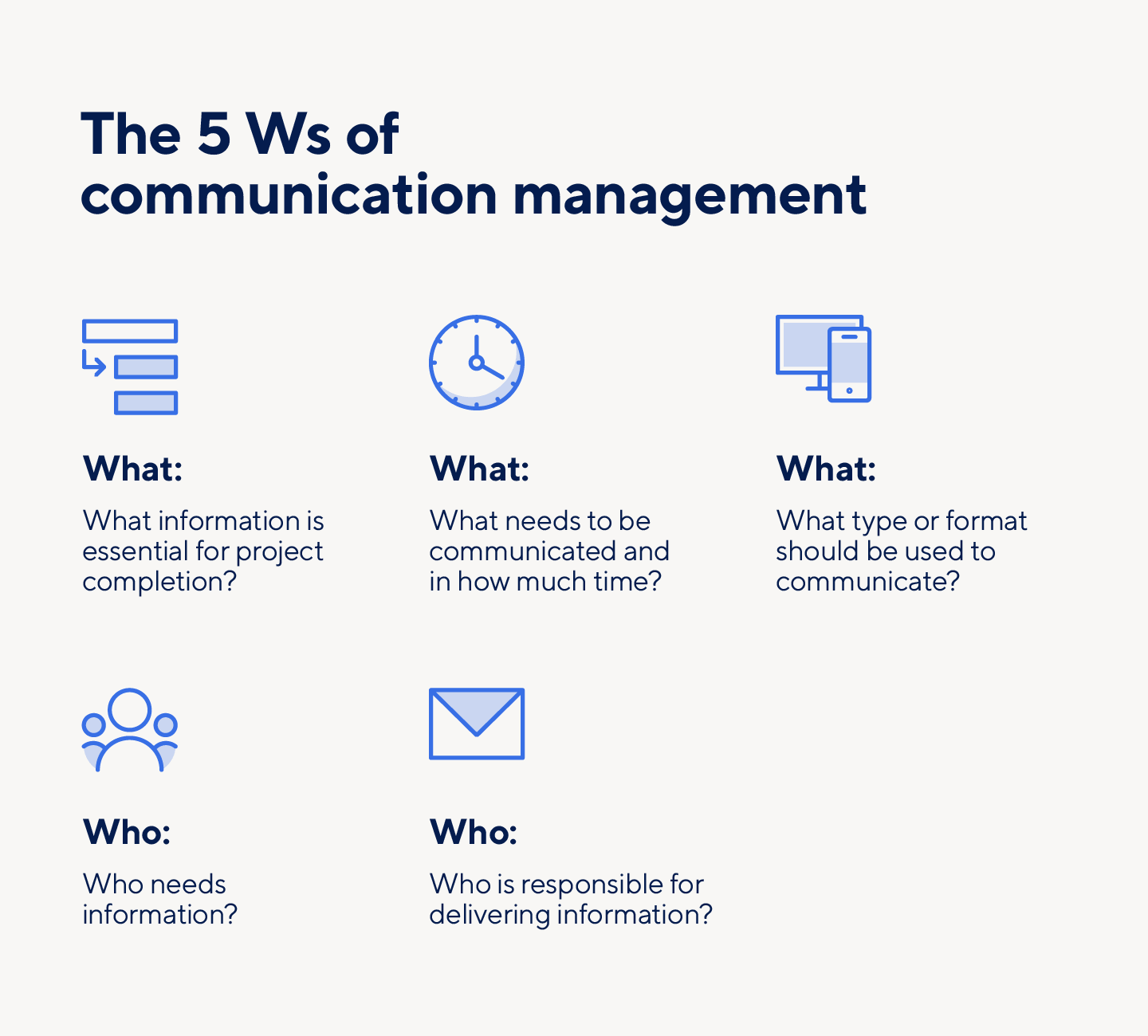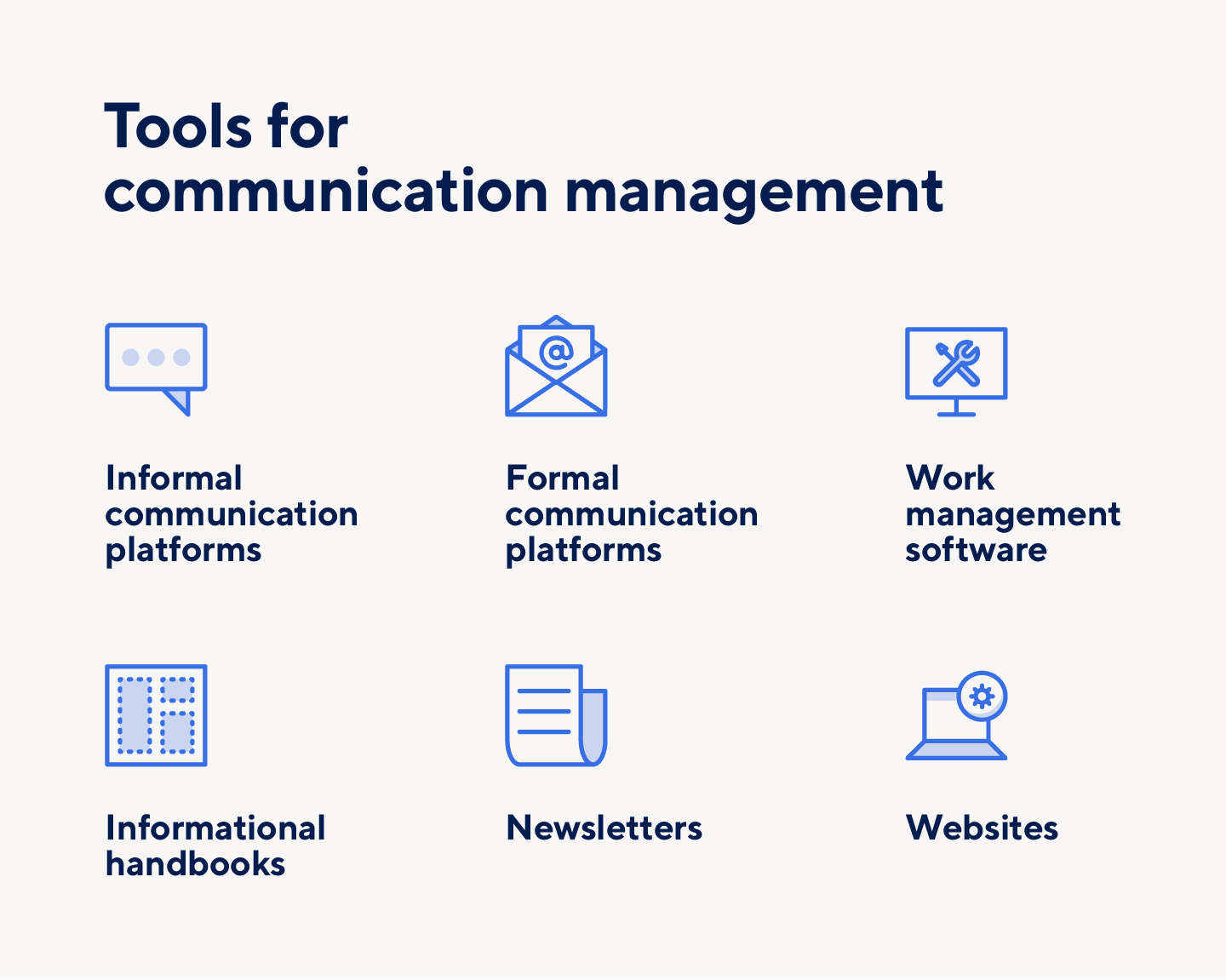What Is Communication Management?
Communication management refers to the different ways an organization distributes information to integral parties throughout the project lifecycle. A business can manage two different types of communication through this process:
- Internal communication: Communication that occurs between members within an organization or business — via emails, training, company memos, and more — is considered internal communication.
- External communication: Communication between an organization and outside parties — including the media, customers, vendors, and investors — is considered external communication.
Customer communication management also identifies target audiences, their preferred communication styles, and the best way to communicate about products and services.
The 5 Ws of Communication Management
Communication managers should follow the 5 Ws of communication management. These guidelines answer a few key questions:
- What information is essential for project completion?
- What needs to be communicated, and how long will it take to communicate?
- What type or format should be used to communicate?
- Who needs information?
- Who is responsible for delivering information?
Answering these questions can help organizations establish strong, successful communication management plans. However, these are simply guidelines that you can build upon to address the variety of complex circumstances that can arise in corporate communication.
Communication Management Benefits
When implemented correctly and updated consistently, communication management can produce a variety of benefits, including building a culture of trust, collaboration, and accountability among team members.
Effective communication management can help you to do the following:
- Create a trusting environment: Organizations that prioritize internal communication management allow all parties to communicate expectations, frustrations, and ideas in a safe, welcoming environment.
- Promote remote collaboration: Communication management plans allow for efficient and effective remote collaboration — no matter where team members are located.
- Encourage accountability: Individuals within an organization and target audiences are both held accountable for their actions — and inaction. Communication management creates a clear plan for continued collaboration and conversation about complex topics.
- Maintain company culture: When communication is encouraged, it promotes and maintains a company’s culture in both in-person and online communities by making employees feel valued and effective in their professional lives.
- Increase team morale: Effective management plans encourage constructive feedback, which can instill professional confidence in all team members.
- Set clear expectations: Communication management plans outline when communication is expected, which platforms to use, whom to contact, and other necessary steps for keeping projects in motion.
- Enhance relationships: Clear expectations and communication channels can positively impact the relationships among team members, managers, leaders, and audience members.
- Improve efficiency: Communication management plans allow teams to communicate project details effectively without being confused about what to do, who should do it, when to do it, and where it belongs.
- Decrease risk: If adhered to, management plans can decrease the risks associated with inadequate communication across all types of projects — including innovative marketing plans.
The 3-Step Process
Whether your team’s communication is asynchronous or not, a simple, three-step process is crucial for communication management. The steps include creating a management plan, managing the plan, and monitoring the plan.
1. Create a Communication Management Plan
Prioritizing communication management calls for you to create a communication plan. This plan should document the following specific, crucial items throughout a project’s lifecycle:
- Frequency: The communication plan should document how frequently messages and information will be sent and received.
- Target audience: The communication plan should record each target audience group in the project, and the type of communication they will receive.
- Intent: The communication plan should note the specific purpose of each communication message in the project, along with instructions for progress reports.
- Platform: The communication plan should note which communication channels should be used when, and for which type of message.
The purpose of this plan is to set clear expectations for every communicator. It should include detailed descriptions of the above items, as well as any additional information an organization believes would benefit its communication management.
2. Manage the Plan
After the communication plan has been created and approved, it’s the project manager’s responsibility to manage it. This plan should be flexible, allowing teams and organizations to make changes to their strategies based on participant feedback.
If you are managing the communications of a remote team — or a hybrid team with remote workers — this step of the process will encourage you to implement both synchronous and asynchronous communication strategies. No matter how communication occurs, project managers are responsible for monitoring progress, implementing new ideas, and communicating any changes in the plan as soon as possible.
3. Monitor Communication
Not every team or team member needs to receive every single piece of communication. Instead, effective communication and project monitoring means that managers control who receives communication for specific projects, products, and services, as appropriate.
This step identifies crucial communication components, including project statuses, performance, risks, and budgets, and determines who actually needs the information. Project managers monitoring communication can keep track of communication patterns without overwhelming team members or audience members with unnecessary information.
Communication Management Tools
Choosing the correct communication management tools for both internal teams and external parties can help you control who receives your messages and how you communicate with coworkers, managers, and target audiences.
Informal Communication Platforms
Plenty of internal communication occurs across informal communication platforms — especially instant messaging platforms. These simple, direct channels can help team members communicate a variety of project details. Other platforms, like direct messaging and text messaging, can be effective external communication management tools.
Formal Communication Platforms
While informal platforms are great for quick, one-off conversations, formal communication platforms — like email, phone calls, seminars, and meetings — are best for continued, professional communication. These channels can be used both internally and externally throughout the life cycle of a project.
Newsletters
Whether it’s sent only to employees or distributed to the external audiences of an organization, a company newsletter is an effective way to communicate various project details. Employee-only newsletters can be used for project updates, calling out team achievements, and company news. A newsletter distributed to external audiences can still provide major project updates, and it can also highlight company events and include employee spotlights.
Informational Handbooks
Informational handbooks are used mainly for internal communications. They can provide company employees with exact role expectations, outline the various communication platforms available, and explain the communication chain within the organization.
Websites
It’s no secret that an online presence is important to organizational success. When it comes to communication management, websites are an incredibly effective way to manage corporate branding, deliver specific product and service messages, and provide external audiences with a one-stop shop for all their communication needs. All organizations should consider their communication management plans when initially creating or redesigning a website.
Work Management Software
Communication management and work management go hand in hand. A communication plan should include the use of work management software and tools to ensure that projects effectively move through their lifecycles.
Management Communication Skills
Communication management can only be as effective as the skills and qualities of the participating individuals. To increase the likelihood of a successful management plan, both internal and external users need to employ a few specific skills:
- Active listening: All project members must actively listen, respond, and seek answers to concerns communicated by other teams, stakeholders, and audience members.
- Organization: Project steps should include clear expectations for creating more efficient and effective future projects.
- Constructive feedback: Leadership and management conversations should include employable feedback designed to enhance the quality of a project.
- Time management: Communicating in a timely fashion keeps projects on time for completion and lets external stakeholders know that their concerns and ideas matter.
- Conflict resolution: Team members and management should be aware of how to solve conflicts efficiently and respectfully — or understand how to mediate in the face of a crisis.
- Consistency: Brand voice should be consistent across all organizational communication, and team members should confidently know how frequently to respond to project communications.
Streamline Communication With Real-Time Work Management in Smartsheet
Empower your people to go above and beyond with a flexible platform designed to match the needs of your team — and adapt as those needs change.
The Smartsheet platform makes it easy to plan, capture, manage, and report on work from anywhere, helping your team be more effective and get more done. Report on key metrics and get real-time visibility into work as it happens with roll-up reports, dashboards, and automated workflows built to keep your team connected and informed.
When teams have clarity into the work getting done, there’s no telling how much more they can accomplish in the same amount of time. Try Smartsheet for free, today.


